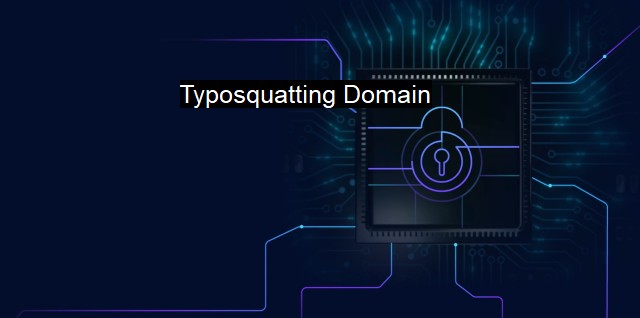What is Typosquatting Domain?
Safeguarding Your Business Against the Threat of Typosquatting Domain: Understanding the Practice and Its Effects on Online Businesses
Typosquatting Domain, or URL hijacking, is a shady practice seen in the internet world that involves profiting from typographical errors, primarily made by internet users when entering website addresses into their web browser. Its presence highlights neglected security loopholes, demonstrating why best practices in cybersecurity are necessary."Typosquatting Domain" is a form of cybersquatting, in which individuals register domain names of universally popular websites but with typos, riding on the probability that some users may mistype their desired website address while typing rapidly or carelessly. Depending on the specific intent, Typosquatting can serve as either a simple advertising tactic or take a more nefarious form where personal information of users gets exploited.
Typosquatters, the perpetrators, typically take one of two routes. On less innocuous occasions, they redirect unsuspecting internet users to alternative websites akin to the intended site. These websites frequently contain clickable adverts and the typosquatter earns advertisement revenue from each click. Unsuspecting users may essentially view the correct information, but the peculiarity may be a nuisance.
Far more concerning is when Typosquatting is used to con users who stumble upon a deceitful website by actually believing it is the original one. These mimic websites have a strong resemblance to popular sites, looking legitimate and trustworthy. For instance, typosquatters often clone popular banking or eCommerce sites where users willingly input sensitive information. From the typosquatters viewpoint, earning users' trust then exploiting them is part of their strategy.
They capitalize on human mistakes to phish, or essentially trick targets into providing sensitive data. With this data, cybercriminals can engage in identity theft, defrauding credit cards, or for other fraudulent objectives. This incredibly deceptive form of internet fraud vividly underlines the importance of cybersecurity initiatives and antivirus protection.
From another perspective, the harsh reality of such cybersquatting activities is that they dent recognizable brands' reliability and standing. Hence, brand reputation takes a knock, and damage control becomes a cumbersome chore when users end up blaming them rather than the perpetrator of these cybersecurity issues.
Acting upon such cybersecurity challenges requires a multi-faceted solution. Technological solutions include URL filtering and misspelling recognition. These techniques can determine Cyber threats and notify users before a website is visited. These techniques alone are not sufficient safeguards due to the evolving nature of Cyber threats.
Corporations can take proactive measures and implement protective strategies. Domain name monitoring can identify potential threats before they become a substantial issue. Corporations can also rectify the problem by legally seeking ownership of typosquatted domain names. Individuals must also be proactive and vigilant while online, especially while inputting personal information.
An exception on typing errors prevents most common typosquatting. Regular antivirus updates and a reliable cybersecurity suite can prevent, detect, or remove malicious software from your device before it causes any substantial damage. In advanced cases, machine learning can pick unusual patterns, effectively alerting and protecting businesses and individuals.
Typosquatting relies on innocent slips to maliciously exploit both corporations and individuals. Therefore, it is crucial to emphasize the importance of a comprehensive strategy that combines cybersecurity best practices, such as machine learning, antivirus software, and increased public awareness to combat this menace. As typosquatting is getting increasingly sophisticated, a multifaceted and consistent approach must be adopted to tackle this problem.

Typosquatting Domain FAQs
What is typosquatting domain?
Typosquatting domain is a cyber attack where scammers register domain names that are similar to legitimate websites with the intent of tricking users into visiting the fake website and stealing their data.How does typosquatting domain occur?
Typosquatting domain occurs when a user mistypes a URL or a domain name in the browser. The scammers register similar domain names with commonly mistyped words, such as replacing a letter with a similar-looking symbol or adding an extra letter to a word.What are the risks of typosquatting domains?
The risks of typosquatting domains include the theft of sensitive data such as passwords, credit card information, and personal identity data. The fake websites can also contain malicious links or malware that can infect the user's device.How can I protect myself from typosquatting domains?
To protect yourself from typosquatting domains, you should always double-check the URL and domain name spelling before entering it in the browser. You can also use anti-virus software that can detect and block fake websites. Additionally, you can enable extensions like Domain Name System (DNS) filtering that can warn you and block access to malicious websites.| | A | | | B | | | C | | | D | | | E | | | F | | | G | | | H | | | I | | | J | | | K | | | L | | | M | |
| | N | | | O | | | P | | | Q | | | R | | | S | | | T | | | U | | | V | | | W | | | X | | | Y | | | Z | |
| | 1 | | | 2 | | | 3 | | | 4 | | | 7 | | | 8 | | |||||||